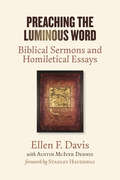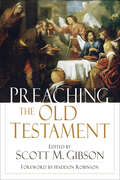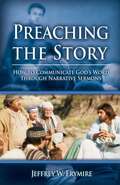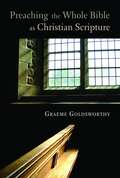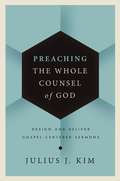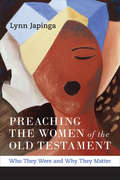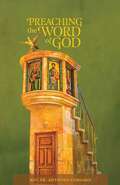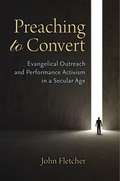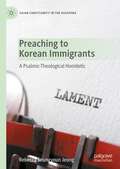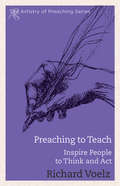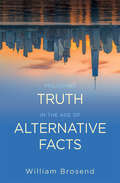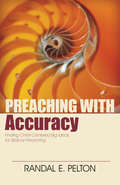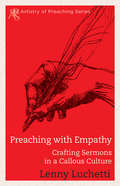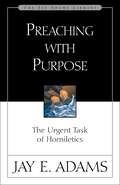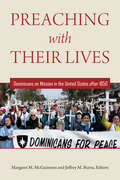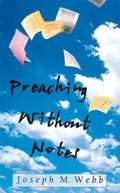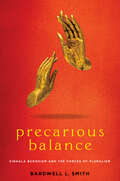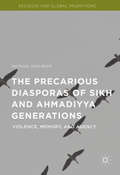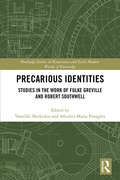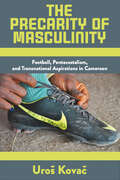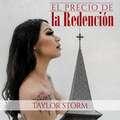- Table View
- List View
Preaching the Luminous Word: Biblical Sermons and Homiletical Essays
by Ellen F. Davis Austin McIver DennisInsights from one of the most distinctive and eloquent scholar-preachers of our time Inviting serious theological engagement with texts from all parts of the Christian Bible, Preaching the Luminous Word is a collection of fifty-one sermons and five related essays from noted preacher and biblical scholar Ellen F. Davis. A brief preface to each sermon delineates its liturgical context and theological themes as well as distinctive elements of structure and style. Arranged in canonical order, the sermons treat a wide range of texts: Torah, Prophets, Writings, Gospels, Epistles, and Revelation. They are complemented by essays on various aspects of biblical interpretation for preaching. At once accessible, theologically informed, and rhetorically rich, this volume will engage preachers, teachers, seminarians, church leaders, and serious lay readers.
Preaching the Luminous Word: Biblical Sermons and Homiletical Essays
by Austin McIver Dennis Ellen F. DavisInsights from one of the most distinctive and eloquent scholar-preachers of our time Inviting serious theological engagement with texts from all parts of the Christian Bible, Preaching the Luminous Word is a collection of fifty-one sermons and five related essays from noted preacher and biblical scholar Ellen F. Davis. A brief preface to each sermon delineates its liturgical context and theological themes as well as distinctive elements of structure and style. Arranged in canonical order, the sermons treat a wide range of texts: Torah, Prophets, Writings, Gospels, Epistles, and Revelation. They are complemented by essays on various aspects of biblical interpretation for preaching. At once accessible, theologically informed, and rhetorically rich, this volume will engage preachers, teachers, seminarians, church leaders, and serious lay readers.
Preaching the Old Testament
by Scott M. GibsonPreaching the Old Testament equips pastors to journey into the forest and find a passion and confidence for preaching on the Old Testament.
Preaching the Story: How to Communicate God's Word Through Narrative Sermons
by Jeffrey W. FrymirePreaching the Story explores why communication is more effective when sermons are no longer lectures but stories. It explains how to deliver your entire sermon in story form. A practical book for pastors and ministerial students.
Preaching the Whole Bible as Christian Scripture: The Application of Biblical Theology to Expository Preaching
by Graeme GoldsworthyWhile strong, gospel-centered preaching abounds, many Christian pastors and lay preachers find it difficult to preach meaningfully from the Old Testament. This practical handbook offers help. Graeme Goldsworthy teaches the basics of preaching the whole Bible in a consistently Christ-centered way.Goldsworthy first examines the Bible, biblical theology, and preaching and shows how they relate in the preparation of Christ-centered sermons. He then applies the biblical-theological method to the various types of literature found in the Bible, drawing out their contributions to expository preaching focused on the person and work of Christ.Clear, complete, and immediately applicable, this volume will become a fundamental text for teachers, pastors, and students preparing for ministry.
Preaching the Whole Counsel of God: Design and Deliver Gospel-Centered Sermons
by Julius Kim Michael HortonPreaching the Whole Counsel of God is a primary textbook on the art and science of preaching for pastors and pastors-in-training that teaches you how to practice expository, Christ-focused hermeneutics, combined with Gospel-centered, audience-transforming homiletics. It will guide you to: Discover the truth of the text according to the human author. Discern Christ in the text according to the divine author. Design your sermon with truth, goodness, and beauty. Deliver your sermon in a way that keeps attention, retention, and leads to transformation.
Preaching the Women of the Old Testament: Who They Were And Why They Matter
by Lynn JapingaTake an in-depth look at over twenty fierce, faithful, and strong women featured in the Old Testament with Preaching the Women of the Old Testament. Inside this unique resource author Lynn Japinga interprets the stories of various biblical women, including Eve, Rebekah, Dinah, Tamar, Miriam, Deborah, Jael, Abigail, Bathsheba, and Vashti. Along with providing an interpretation, Japinga demonstrates how the character's story has been read in Christian tradition and offers sermon ideas that connect contemporary issues to each story. This book is ideal for pastors who want to know more about the many women of the Old Testament and learn how to better incorporate them into their sermons.
Preaching the Word of God (The Saint John Chrysostom Lectures on Preaching)
by Anthony M. ConiarisFather Anthony Coniaris, a priest of the Greek Orthodox Church, an outstanding preacher of deep faith, and a prolific author, was invited to give the third annual Saint Chrysostom Lectures on Preaching. In place of the three lectures given at Holy Cross, Father Coniaris generously offered Holy Cross Press an entire volume entitled: Preaching the Word of God. Although directed primarily to those who preach or wish to preach the word of God, the present volume offers much more in terms of spiritual nourishment to all Christians. It is in fact a book that can be read with great profit by everyone interested in a living faith.
Preaching To Convert: Evangelical Outreach And Performance Activism In A Secular Age
by John FletcherPreaching to Convert offers an intriguing new perspective on the outreach strategies of U. S. evangelicals, framing them as examples of activist performance, broadly defined as acts performed before an audience in the hopes of changing hearts and minds. Most writing about activist performance has focused on left-progressive causes, events, and actors. Preaching to Convert argues against such a constricted view of activism and for a more nuanced understanding of U. S. evangelicalism as a movement defined by its desire to win converts and spread the gospel. The book positions evangelicals as a diverse, complicated group confronting the loss of conservative Christianity's default status in 21st-century U. S. culture. In the face of an increasingly secular age, evangelicals have been reassessing models of outreach. In acts like handing out Bible tracts to strangers on the street or going door-to-door with a Bible in hand, in elaborately staged horror-themed morality plays or multimillion-dollar creationist discovery centers, in megachurch services beamed to dozens of satellite campuses, and in controversial "ex-gay" ministries striving to return gays and lesbians to the straight and narrow, evangelicals are redefining what it means to be deeply committed in a pluralist world. The book's engaging style and careful argumentation make it accessible and appealing to scholars and students across a range of fields.
Preaching to Korean Immigrants: A Psalmic-Theological Homiletic (Asian Christianity in the Diaspora)
by Rebecca Seungyoun JeongIn terms of practical-theology’s critical reflection on marginalized people’s wounds in a wider society, this book investigates the question, “How to proclaim the good news in response to first-generation Korean immigrants’ contextual suffering in the United Sates?” To answer the question, the book starts with investigating Korean immigrant hearers’ contextual predicaments in a new land to point out emerging practical-theological issues in relation to the practice of preaching. In this book, the primary subjects are first-generation Korean immigrants, especially those who have relatively low socio-economic status and struggle with the purpose of their lives as immigrants, particularly those whose material dreams have been shattered.In order to proclaim the good news, this book proposes a more appropriate immigrant theology for/in the practice of preaching by reclaiming the priorities of God’s future in our lives and confirming God’s active identification with Korean immigrant congregations in the depths of their predicament. Such reconstructive work for immigrant theology arises in response to their existential hardships, marginality, ethnic discrimination, and relative powerlessness in life.While acknowledging both the possibilities and limits of the diverse forms of current Korean immigrant preaching, the book then offers a strategic proposal for a new homiletic theory, namely “a psalmic-theological homiletic.” This proposed homiletic is deeply rooted in the theology of the Psalms and their rhetorical movement. This re-envisioned mode of eschatological and prophetic preaching in times of difficulty recovers ancient Israel’s psalmic, rhetorical tradition that aims toward faith. Its theological-rhetorical strategy intends to both transform hearers’ habitus of living in faith and enhance their hope-filled life through communal anticipation of God’s coming future on the margins. Specifically, this proposed homiletic critically adopts key features from psalms of lament and their typical, fourfold theological-rhetorical movement (i.e., lament, retelling a story, confessional doxology, and obedient vow) as now core elements of a revised Korean-immigrant preaching practice.
Preaching to Teach: Inspire People to Think and Act
by Richard VoelzPreaching to Teach merges the related functions of preaching and teaching, and equips the reader to accomplish both. Preachers stand up to speak each week in challenging times to unsettled congregations. Each week seems to bring a new difficult subject: mass shootings and other forms of violence; hard conversations around race, ethnicity, and multi-religious contexts; immigration; poverty; climate change; foreign and domestic terrorism; and bickering about it all on social media. Preachers are hungry for ways to envision the work of preaching in these times, as well as for tools that will help them speak to difficult and contentious topics. In a divided and weary world, preachers struggle with the choice of any number of “images” to describe their preaching identity. Responding to social crisis after social crisis, preachers most often lean toward the roles of pastor, prophet, or somewhere on the spectrum in between the two. Juggling between these images and their associated roles on a week-to-week basis can be exhausting. But there is an ancient image of the preacher that may help: the preacher as teacher. The image of teacher has traditionally focused on content and rhetorical aspects of preaching: the preacher is conveying information, modeling theological reasoning, or effecting a certain pulpit style. But rather than focusing on traditional concepts of teaching to determine the content, form, style, or delivery of sermons, the field of critical pedagogy (represented by notable figures such as Paulo Freire, Henry Giroux, Peter McLaren, and bell hooks) offers a way of re-envisioning the preacher-as-teacher. Recasting the preacher-as-teacher through the lens of critical pedagogy grounds the image of teacher in an ethical framework, inviting preachers to redefine their public roles, stand in relationships of solidarity with communities of faith, break the silences of taboos, tackle tough issues, and re-imagine the world in the shape of the kingdom of God.
Preaching Truth in the Age of Alternative Facts
by William BrosendWhile comedian Stephen Colbert was remarkably prescient some years ago when he introduced the word “truthiness” to our vocabulary, it was presidential advisor Kellyanne Conway who told us that there are “alternative facts” abroad in the land. Rarely has such an offhand comment so captured the imagination while also aptly summarizing the spirit of the age. The late Daniel Patrick Moynihan famously said that while everyone is entitled to his (or her) opinion they are not entitled to their own facts. Until now. Good preaching has always been a challenge, a combination of exegesis, insight and craft in witness to the Gospel and in service of the Church. Cultural forces, in particular the proliferation of media outlets and the explosion of available entertainment sources, have only made the challenge greater. And that was when most agreed on a common set of facts. Those days are now past and gone, and preachers may be forgiven if at times it feels as if the task is impossible: The pulpit is like a tightrope, stretched between red and blue, Republicans and Democrats, conservatives and liberals. And there is no net. I read the Beatitudes last Sunday and the tension in the church was palpable. Who knew “Blessed are the peacemakers” were fighting words? Everything I say is being interpreted and analyzed for things I never even thought about. Joshua and the Battle of Jericho has become a commentary on whether or not we should build a wall on the border. I cannot believe how angry people are. I’m old enough to remember when the big difference was whether you got your news from Walter Cronkite on CBS or Huntley/Brinkley on NBC. Now no one agrees on what constitutes news. Or facts. Truth in the Age of Alternative Facts offers a way forward. This is a book for preachers, teachers, and other leaders, along with students of preaching. It demonstrates how to proclaim honest, faithful, candid sermons, in spite of social and political disagreements. It teaches how to preach in a way that allows the Church to be its best self—a place of commitment, engagement, acceptance and compassion for all God’s children.
Preaching with Accuracy: Finding Christ-Centered Big Ideas for Biblical Preaching
by Randal E. PeltonA resource to help pastors correctly identify the big idea of a passage and apply it wellPreaching with Accuracy provides preachers with a method for finding the “big idea” in each passage of the Bible, since correctly identifying the main point is key to accurately conveying the essential theology of the passage.Pelton lays out a reliable, well-informed method for identifying the main point of a preaching passage and understanding that passage well in its context. Numerous examples are given at each step of the way to show how meaning develops throughout the process of interpretation. Pelton then guides the preacher through applying a Christ-centered hermeneutic that will result in biblical sermons that benefit and equip believers.
Preaching with Empathy: Crafting Sermons in a Callous Culture (Artistry of Preaching)
by Lenny LuchettiPreachers can find help from many resources to get the text right, the structure right, and the delivery right. Preaching with Empathy aims to help preachers and homiletics students learn to deeply understand and love their listeners, in order to get preaching right. Preachers who profess a love for God, Scripture, and preaching, but who lack loving empathy for the listener, betray their three professed loves and limit their fruitfulness in ministry. This book teaches how to practice preaching in new ways, incorporating a heightened awareness and empathy for the people in the preacher’s community. Author Lenny Luchetti provides immediately useful tools, all based on the foundations of scripture, theology, history, and social awareness. Readers will learn to embody Christ for their congregations, as they empathically love God and humanity. This book is part of the successful Artistry in Preaching series, edited by Paul Scott Wilson. Other books in the series include Preaching as Poetry: Beauty, Goodness and Truth in Every Sermon, by Paul Scott Wilson; Actuality: Real Life Stories for Sermons that Matter, by Scott Hoezee; and Preaching in Pictures: Using Images for Sermons that Connect, by Peter Jonker.
Preaching with Purpose: The Urgent Task of Homiletics
by Jay E. Adams"The amazing lack of concern for purpose among homileticians and preachers has spawned a brood of preachers who are dull, lifeless, abstract and impersonal; it has obscured truth, hindered joyous Christian living, destroyed dedication and initiative, and stifled service for Christ." –Jay Adams, from the book Preaching needs to become purposeful, says Jay Adams, because purposeless preaching is deadly. This book was written to help preachers and students discover the purpose of preaching has and the ways that the Scriptures inform and direct the preaching task. Preaching with Purpose, like the many other books of Jay Adams, speaks clearly and forcefully to the issue. Having read this book, both students and experienced preachers will be unable to ignore the urgent task of purposeful preaching. And the people of God will be the better for it.
Preaching with Their Lives: Dominicans on Mission in the United States after 1850
by Margaret M. McGuinness and Jeffrey M. BurnsThis volume tells the little-known story of the Dominican Family—priests, sisters, brothers, contemplative nuns, and lay people—and integrates it into the history of the United States. Starting after the Civil War, the book takes a thematic approach through twelve essays examining Dominican contributions to the making of the modern United States by exploring parish ministry, preaching, health care, education, social and economic justice, liturgical renewal and the arts, missionary outreach and contemplative prayer, ongoing internal formation and renewal, and models of sanctity. It charts the effects of the United States on Dominican life as well as the Dominican contribution to the larger U.S. history. When the country was engulfed by wave after wave of immigrants and cities experienced unchecked growth, Dominicans provided educational institutions; community, social, and religious centers; and health care and social services. When epidemic disease hit various locales, Dominicans responded with nursing care and spiritual sustenance. As the United States became more complex and social inequities appeared, Dominicans cried out for social and economic justice. Amidst the ugliness and social dislocation of modern society, Dominicans offered beauty through the liturgical arts, the fine arts, music, drama, and film, all designed to enrich the culture. Through it all, the Dominicans cultivated their own identity as well, undergoing regular self-examination and renewal.
Preaching Without Contempt: Overcoming Unintended Anti-Judaism
by Marilyn J. SalmonMarilyn Salmon's persuasive and practical work helps preachers to identify the ways that Christian preachers perpetuate the long tradition of Christian anti-Judaism. She situates the Gospels precisely as Jewish literature then addresses specific thorny issues that arise in preaching: supersession ism; portrayals of the Law; the Pharisees; the relationship between the Testaments; preaching the Passion; and misrepresentations of Judaism. Using examples from many sermons, she shows how to avoid the pitfalls of mis-portraying the people of Jesus.
Preaching Without Notes
by Joseph M. WebbIn this important book, Webb makes two central claims. First, that effective preaching without a manuscript is not a matter of talent as much as it is a matter of preparation. Preachers can learn the practices and disciplines that make it possible to deliver articulate, thoughtfully crafted sermons, not from a written page, but as a natural, spontaneous act of oral communication. Throughout the book, the author offers specific examples including a transcript of a sermon preached without manuscript or notes. Second, that the payoff of learning to preach without a manuscript is nothing less than sermons that more effectively and engagingly give witness to the good news.
Precarious Balance: Sinhala Buddhism and the Forces of Pluralism (Studies in Religion and Culture)
by Bardwell L. SmithSince the third century BCE, when the king of Sri Lanka converted to Buddhism, the island nation off the southern coast of India has represented a central interest of Buddhist scholarship. The association between its politics and religious life has not always remained harmonious, however, and has contributed to the contemporary turmoil that threatens to tear it apart. In this valuable book, renowned religious scholar Bardwell Smith elucidates the history of Buddhism in Sri Lanka from the time of one of its earliest rulers through to its present-day strife.The essays collected here for the first time explore various themes of Sri Lanka’s long history in novel and constructive ways. Topics include Sinhala Buddhists’ sense of manifest destiny arising from Sri Lanka’s oldest historical chronicles, the Mahavamsa and the Dipavamsa; the nationalist implications of the chronicles’ depiction of the third-century Mahavihara monastery as the site of "original Buddhism"; and concepts of order and legitimation of power in ancient Ceylon. With a new introduction and final chapter, Smith sheds fresh light on today’s Sri Lanka, connecting historical studies with contemporary issues.
The Precarious Diasporas of Sikh and Ahmadiyya Generations
by Michael NijhawanThis book examines the long-term effects of violence on the everyday cultural and religious practices of a younger generation of Ahmadis and Sikhs in Frankfurt, Germany and Toronto, Canada. Comparative in scope and the first to discuss contemporary articulations of Sikh and Ahmadiyya identities within a single frame of reference, the book assembles a significant range of empirical data gathered over ten years of ethnographic fieldwork. In its focus on precarious sites of identity formation, the volume engages with cutting-edge theories in the fields of critical diaspora studies, migration and refugee studies, religion, secularism, and politics. It presents a novel approach to the reading of Ahmadi and Sikh subjectivities in the current climate of anti-immigrant movements and suspicion against religious others. Michael Nijhawan also offers new insights into what animates emerging movements of the youth and their attempts to reclaim forms of the spiritual and political.
Precarious Identities: Studies in the Work of Fulke Greville and Robert Southwell (Routledge Studies in Renaissance and Early Modern Worlds of Knowledge)
by Vassiliki Markidou Afroditi-Maria PanaghisThis book investigates the construction of identity and the precarity of the self in the work of the Calvinist Fulke Greville (1554–1628) and the Jesuit Robert Southwell (1561–1595). For the first time, a collection of original essays unites them with the aim to explore their literary production. The essays collected here define these authors’ efforts to forge themselves as literary, religious, and political subjects amid a shifting politico-religious landscape. They highlight the authors’ criticism of the court and underscore similarities and differences in thought, themes, and style. Altogether, the essays in this volume demonstrate the developments in cosmology, theology, literary conventions, political ideas, and religious dogmas, and trace their influence in the oeuvre of Greville and Southwell.
The Precarity of Masculinity: Football, Pentecostalism, and Transnational Aspirations in Cameroon
by Uroš KovačSince the 1990s, an increasing number of young men in Cameroon have aspired to play football as a career and a strategy to migrate abroad. Migration through the sport promises fulfillment of masculine dreams of sports stardom, as well as opportunities to earn a living that have been hollowed out by the country’s long economic stalemate. The aspiring footballers are increasingly turning to Pentecostal Christianity, which allows them to challenge common tropes of young men as stubborn and promiscuous, while also offering a moral and bodily regime that promises success despite the odds. Yet the transnational sports market is tough and unpredictable: it demands disciplined young bodies and introduces new forms of uncertainty. This book unpacks young Cameroonians' football dreams, Pentecostal faith, obligations to provide, and desires to migrate to highlight the precarity of masculinity in structurally adjusted Africa and neoliberal capitalism.
The Precarity of Masculinity: Football, Pentecostalism, and Transnational Aspirations in Cameroon
by Uroš KovačSince the 1990s, an increasing number of young men in Cameroon have aspired to play football as a career and a strategy to migrate abroad. Migration through the sport promises fulfillment of masculine dreams of sports stardom, as well as opportunities to earn a living that have been hollowed out by the country’s long economic stalemate. The aspiring footballers are increasingly turning to Pentecostal Christianity, which allows them to challenge common tropes of young men as stubborn and promiscuous, while also offering a moral and bodily regime that promises success despite the odds. Yet the transnational sports market is tough and unpredictable: it demands disciplined young bodies and introduces new forms of uncertainty. This book unpacks young Cameroonians' football dreams, Pentecostal faith, obligations to provide, and desires to migrate to highlight the precarity of masculinity in structurally adjusted Africa and neoliberal capitalism.
Preceramic Mesoamerica
by Jon C. LohsePreceramic Mesoamerica delivers cutting-edge research on the Mesoamerican Paleoindian and Archaic periods. The chapters address a series of fundamental questions in American archaeology including the peopling of the Americas, human adaptations to late glacial landscapes, the Neolithic transition, and the origins of sedentism and early village life. This volume presents innovative and previously unpublished research on the Paleoindian and Archaic periods and evaluates current models in light of new findings. Examples include breakthroughs in dating Mesoamerica’s earliest sites and their implications for models of hemispheric colonization; the transition to postglacial patterns of settlement and subsistence; divergent pathways to initial sedentism; the possibility of Archaic-period monumentality; changing patterns of interregional exchange and interaction; and debates surrounding the origins of agriculture, ceramics, and full-time village life. The volume provides a new perspective on the Mesoamerican Preceramic for students and scholars in archaeology, anthropology, and history. Readers will come to understand how the Preceramic contributed to the emergence of the cultural traditions that anthropologists recognize as Mesoamerica.
El Precio de la Redención
by Taylor StormEs mejor que todos luchemos por llevar una buena vida moral, como vemos en esta historia de crimen donde las acciones de todas las personas afectan a otras. El precio de la redención es grande, pero el del pecado es aún mayor. Todo depende de la naturaleza básica de una persona determinada y de la vida que se le dé. Las vidas de Dolan, Iván, Lily, Cynthia y el padre Ignacio prueban esto. Todos encuentran la redención, cada uno a su manera, en su propio tiempo, en sus propias formas religiosas. Para otros, la redención puede resultar sumamente costosa. En el caso de Lily, su infancia malcriada y el haber sido criada en una familia militar que estaba en problemas la llevaron a buscar consuelo en cosas materiales. La auto esclavitud y las compras compulsivas ayudaron a Lily a lidiar con la muerte de su padre. Su codicia la llevó a cometer uno de los pecados más atroces, el acto de asesinar. No fue hasta que fue a la cárcel que finalmente encontró algo de redención. Iván era el peor de los padres, creyendo que sus costumbres de culto luciferino le daban a uno el derecho a abusar, torturar y matar a otros. Como había estado en los círculos más altos, sabía a quién podía denunciar todos los delitos de tráfico de drogas, asesinato, tortura y otros actos ilícitos. Aquellos con los que estaba involucrado iban detrás de él ... así que recurrió a la iglesia ortodoxa en busca de ayuda ... El hijo de Iván, Nolan, después de ver morir a su madre y su hermana en un incendio, del que estaba seguro que su padre había comenzado y del cual escapó, creció con guía espiritual. Conoció a Lily y se enamoró. Ella lo ayudó en su trabajo de caridad, pero su adicción a las compras supuso una carga financiera para Nolan y se divorciaron años más tarde, dejando a Lily a la presa de un hombre que conoció y que creía que era rico. Cuando se enteró de que no era así, ella y un conocido planearon su muerte para cobrar el seguro ...<br
